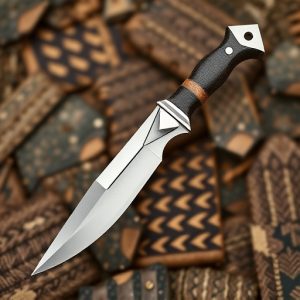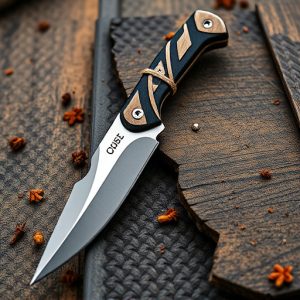Mastering the Art of Double-Sided Throwing Knives: A Guide to Design, Craftsmanship, and Safe Use
The double-sided throwing knife is a specialized tool for both combat sports and tactical operation…….
The double-sided throwing knife is a specialized tool for both combat sports and tactical operations, valued for its dual-edged design that allows for both penetration and slicing. These knives are crafted with precision engineering and artisanal skill to ensure optimal balance, weight distribution, and ergonomic grip for accuracy in flight and impact. High-grade stainless steel is used for durability and resistance to wear and corrosion. Skilled artisans manage the knife's weight distribution through meticulous forging and honing, making it an indispensable weapon where accuracy and reliability are crucial. Mastery of using these knives requires skillful technique and understanding of their symmetrical design, with training emphasizing ambidexterity and adapting to environmental factors like wind and distance. Advanced practitioners refine their throws through grip and release control, with video analysis or mentorship aiding improvement. Safety is paramount throughout the learning process, with strict adherence to local laws and regulations governing ownership and use. A clear, secure practice environment and appropriate protective gear are essential for minimizing risks, as is regular knife maintenance to maintain functionality and safety. Consistent practice and dedication can lead to proficiency in this discipline that intertwines functionality with martial arts discipline.
Explore the intricate world of combat and survival with an in-depth look at the double-sided throwing knife, a versatile tool for tactical professionals and enthusiasts alike. This article delves into its design and functionality, examining how this dual-edged weapon offers precision and efficiency. We’ll also uncover the importance of material selection and craftsmanship that elevate these knives from mere tools to finely tuned instruments of accuracy. Additionally, mastering the art of throwing with a double-sided knife requires skill and practice, which we will guide you through step by step. Safety and legal considerations are paramount when handling such equipment; thus, we’ll address these aspects to ensure responsible use. Join us as we throw light on the double-sided throwing knife’s multifaceted role in various domains.
Understanding the Double-Sided Throwing Knife: Design and Functionality
The double-sided throwing knife is a specialized tool that has garnered attention in both combat sports and tactical scenarios. Its unique design allows for two distinct edges to be utilized, providing an advantage in various situations where rapid deployment and the potential need to engage multiple targets efficiently are paramount. The blade on one side is tailored for penetration, with a sharp, pointed tip that excels at sticking into surfaces upon throw, while the opposite edge boasts a broader, more robust cutting surface, ideal for slice-based impacts.
Craftsmanship in double-sided throwing knives is a blend of art and precision engineering. Balance and weight distribution are critical factors in the design process; these elements determine how the knife will fly through the air and how it will behave upon impact. The handle is ergonomically designed to ensure a firm grip, even when hands are damp or under stress. The center of gravity is carefully calculated to allow for stable flight without compromising on maneuverability. This balance enables users to throw with accuracy, making the double-sided throwing knife a versatile and formidable weapon in the arsenal of self-defense or competitive throwing disciplines.
Material Selection and Craftsmanship: Key Factors in Double-Sided Knife Quality
Crafting a double sided throwing knife requires meticulous attention to both material selection and superior craftsmanship, which are pivotal in determining the quality and effectiveness of the weapon. The choice of materials directly influences the knife’s durability, balance, and performance. High-grade stainless steel is often favored for its strength, corrosion resistance, and sharpness retention. This material ensures that the knife can withstand the rigors of repeated use without losing its edge or succumbing to environmental factors.
The precision in the knife’s construction is equally important. The balance between the two sides must be impeccable for optimal flight and accuracy during throw. Expert artisans employ finely tuned methods, such as forging and honing, to create a uniform weight distribution that allows the knife to travel with a predictable and stable trajectory upon release. Additionally, the edges of each side must be crafted with razor-sharp precision to maximize the impact upon target contact. The result is a double sided throwing knife that combines robust materials with expert craftsmanship, offering users a reliable tool for various applications, from sport to self-defense.
Mastering Techniques: Tips for Effective Throwing with a Double-Sided Knife
Mastering the art of throwing a double-sided throwing knife requires a combination of skill, precision, and an understanding of the weapon’s unique characteristics. To effectively wield such a tool, one must first familiarize themselves with its symmetrical design; each side is sharp and balanced for optimal flight and penetration. Beginners should start by practicing with a single throw to get accustomed to the knife’s feel and weight distribution. Once comfortable, progress to alternating sides on successive throws, which will develop ambidexterity and adaptability in various throwing situations. Consistency is key; regular practice sessions focused on technique will gradually improve accuracy and control. It’s also important to consider the environmental factors, such as wind and distance, as these can significantly affect the trajectory of the knife. Advanced techniques like no-spin or spin throws can be mastered with dedicated practice and a thorough understanding of the physics involved in the flight path of the double-sided throwing knife.
Advanced users looking to refine their skills should focus on perfecting their grip and release, as these elements are critical for successful throws. The grip should allow for a smooth and controlled release that imparts the desired spin or no-spin to the knife. Additionally, understanding the nuances of each throw type—be it a direct, bouncing, or overhead throw—will enhance one’s ability to adapt to different scenarios. Video analysis or working with an experienced mentor can provide valuable insights and feedback to further refine technique. Safety should always be a priority; ensure that there is ample space away from bystanders and that the surface for practice is appropriate to avoid damage to property or injury. With dedication and practice, anyone can become proficient in the use of a double-sided throwing knife, a skill that combines functionality with the allure of martial arts disciplines.
Safety and Legal Considerations When Using Double-Sided Throwing Knives
When engaging with double-sided throwing knives, safety and legal compliance are paramount considerations. It is crucial to adhere to local laws and regulations that govern the use of such weapons, as they can vary significantly from one jurisdiction to another. In some regions, there may be strict restrictions on who can own or use throwing knives, while in others, specific training certifications might be required. Users must always ensure they are fully aware of these legalities before attempting to use a double-sided throwing knife.
Safety protocols must be rigorously followed when practicing with double-sided throwing knives. This includes selecting an appropriate and safe environment, free from bystanders or obstacles that could lead to accidents. The thrower should also invest in quality protective gear, including safety goggles to guard against shrapnel or dirt kicked up by the impact, gloves to protect the hands, and a sturdy target designed to absorb the force of the knife upon impact without rebounding. Regular maintenance of the knives is equally important; ensuring they are sharp and in good condition prevents the risk of the knife failing during use, which could result in injury or damage. Always prioritize safety above all else when handling double-sided throwing knives to prevent accidents and ensure a responsible approach to their use.

